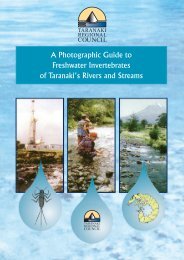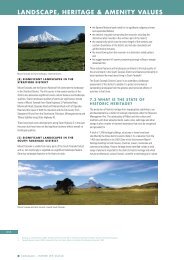Annual report 2006-2007 - Taranaki Regional Council
Annual report 2006-2007 - Taranaki Regional Council
Annual report 2006-2007 - Taranaki Regional Council
You also want an ePaper? Increase the reach of your titles
YUMPU automatically turns print PDFs into web optimized ePapers that Google loves.
Section 11 presents recommendations to be implemented in the <strong>2007</strong>-2008<br />
monitoring year.<br />
A glossary of common abbreviations and scientific terms, and a bibliography, are<br />
presented at the end of the <strong>report</strong>.<br />
1.1.3 The Resource Management Act (1991) and monitoring<br />
2<br />
The Resource Management Act primarily addresses environmental ‘effects’ which<br />
are defined as positive or adverse, temporary or permanent, past, present or future,<br />
or cumulative. Effects may arise in relation to:<br />
(a) the neighbourhood or the wider community around a discharger, and may<br />
include cultural and socio-economic effects;<br />
(b) physical effects on the locality, including landscape, amenity and visual effects;<br />
(c) ecosystems, including effects on plants, animals, or habitats, whether aquatic or<br />
terrestrial;<br />
(d) natural and physical resources having special significance (e.g., recreational,<br />
cultural, or aesthetic);<br />
(e) risks to the neighbourhood or environment.<br />
In drafting and reviewing conditions on discharge permits, and in implementing<br />
monitoring programmes, the <strong>Taranaki</strong> <strong>Regional</strong> <strong>Council</strong> is recognising the<br />
comprehensive meaning of ‘effects’ inasmuch as is appropriate for each discharge<br />
source. Monitoring programmes are not only based on existing permit conditions,<br />
but also on the obligations of the Resource Management Act to assess the effects of<br />
the exercise of consents. In accordance with section 35 of the Resource Management<br />
Act 1991, the <strong>Council</strong> undertakes compliance monitoring for consents and rules in<br />
regional plans; and maintains an overview of performance of resource users against<br />
regional plans and consents. Compliance monitoring, including impact monitoring,<br />
also enables the <strong>Council</strong> to continuously assess its own performance in resource<br />
management as well as that of resource users particularly consent holders. It further<br />
enables the <strong>Council</strong> to continually re-evaluate its approach and that of consent<br />
holders to resource management, and, ultimately, through the refinement of<br />
methods, to move closer to achieving sustainable development of the region’s<br />
resources.<br />
1.1.4 Evaluation of environmental performance<br />
Besides discussing the various details of the performance and extent of compliance<br />
by the companies in the catchment during the period under review, this <strong>report</strong> also<br />
assigns an overall rating. The categories used by the <strong>Council</strong>, and their<br />
interpretation, are as follows:<br />
- a high level of environmental performance and compliance indicates that<br />
essentially there were no adverse environmental effects to be concerned about,<br />
and no, or trivial (such as data supplied after a deadline) non-compliance with<br />
conditions.<br />
- a good level of environmental performance and compliance indicates that adverse<br />
environmental effects of activities during the year were negligible or minor at<br />
most, items of concern were resolved positively, co-operatively, and quickly, the














